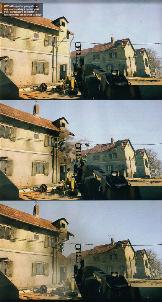Story
Preston Marlowe is a U.S. soldier transferred to Bad Company and embarks on his first mission with his new squad. After a relatively informal introduction to fellow squadmates, Redford, Sweetwater, and Haggard, they begin by seizing Russian artillery positions and turning the guns on advancing enemy armor. Proceeding to knock out several anti-air batteries, clearing the way for advancing armor and taking control of the city of Zabograd, the group stumble upon a Legionnaire encampment: mercenaries whose leader is The Legionnaire (Nathan Osgood), a ruthless commander. The Legionnaires are possibly the deadliest army in the world, according to Sweetwater, who also mentions how each is paid in solid gold bars. Transported to a dock farther away from the U.S. Army, they spot more Legionnaires loading a supply truck with gold. The truck drives past the border into nearby Serdaristan, a neutral state in the conflict. Despite Redford ordering the squad to withdraw from the area, Haggard, excited over the prospect of getting gold, runs after the trucks, unintentionally single-handedly invading a neutral country.
The squad pursues Haggard to stop him from causing further damage. When they find him, mission coordinator Mike-One-Juliet (Jennifer Woodward) calls Redford, stating that he would be subject to a court martial for Haggard's offense, as well as raising his service time. Since they have no other choice but to run, Redford flippantly suggests that they pursue the gold even further to a harbor and a ship that is loaded with gold. The group fights their way there only to get caught by U.S. forces. The Army agrees that the squad will have their charges dropped if they investigate Serdaristan since they are officially AWOL, removing U.S. liability. The squad's orders are to capture the eccentric dictator of Serdaristan, Zavomir Serdar (Stefan Ashton Frank). Soon, Serdaristan is considered at war after shooting down the squad's UH-60 Black Hawk transport helicopter, and the group advances to the dictator's palace by way of his personal golf course, where he tells them that the Legionnaires had invaded in order to pay for his bill. As they attempt to escape, they are informed that the U.S. Army is severing all ties with them, and they must find their own way out. The squad escapes with Serdar on his golden Mil Mi-24 helicopter, pursued by the Legionnaires.
Serdar reluctantly directs them to Serdaristan's military nexus, where the helicopter is used to destroy an oil refinery and the country's internet service station. After a long flight, the helicopter is shot down by a black Ka-52 helicopter in Russia. Preston wakes up alone and, with help from Mike-One-Juliet, is reunited with his squad at a monastery. Serdar, however, is captured, and the squad saves him from execution by the Legionnaires. Escaping in a boat, they leave Serdar on a small, isolated island as the exile he was seeking and arrive in Sadiz, a city under construction somewhere on the Caspian Sea. On the beach, the squad spots the ship they saw earlier in Serdaristan. Advancing past resistance, they learn that the U.S. Army is also mounting an offensive there and fear competition for the gold. They then make a deal to share some of the gold with Mike-One-Juliet in exchange for mission support.
After slowing down the U.S. Army's offensive by blowing up two bridges, the squad reaches a gold-filled garage but is attacked by the Legionnaire in his personal Ka-52, the same helicopter from before. Preston manages to shoot down The Legionnaire, and the squad returns to the gold, only to find the U.S. Army loading it into supply trucks. Presuming defeat, they are spotted by a commanding officer. Redford convinces him that they are Army operatives, and the officer orders them to take a truck of the gold and join the convoy. The squad happily obliges but sneak out of the convoy with their truck while acclaiming their intentions to spend the gold, with Sweetwater intending to pay for his post-graduate study, Haggard wanting to build a monster truck he calls "the Truckasaurus Rex", and Redford wanting to retire and go fishing. Meanwhile, at the Ka-52 crash site, The Legionnaire rises from the burning wreckage, seemingly unhurt, with a vengeful expression.

